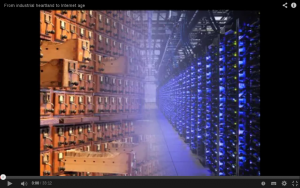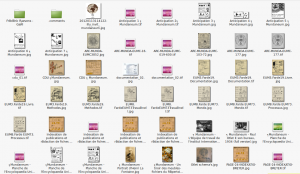Difference between revisions of "The Internet on paper"
From Mondothèque
(→Mundaneum ID) |
Dickreckard (talk | contribs) |
||
| (3 intermediate revisions by one other user not shown) | |||
| Line 1: | Line 1: | ||
| + | <div class="intro">Presentation March 18 in Bergen, Norway. Contribution to [http://bek.no/projects/458-the-extensions-of-many-seminars-on-media-aesthetics?locale=enoc The extensions of many], a seminar curated by [[Dušan Barok]] for BEK, Bergen Center for Electronic Arts.</div> | ||
| + | |||
== Mondotheque == | == Mondotheque == | ||
| + | |||
| + | In 1934, documentalist Paul Otlet wrote: | ||
| + | |||
| + | “Humanity is at a turning point in its history. The mass of available information is formidable. New instruments are necessary for simplifying and condensing it, or the intellect will never know how to overcome the difficulties which overwhelm it, nor realise the progress that it glimpses and to which it aspires”. | ||
| + | |||
| + | Otlet considered radio, cinema, micro-fiche, phonograph and television all worthy substitutes for the book as information carrier. He envisaged them interconnected into a ‘radiated library’, an intellectual multi-media machine that would support the publication, consultation and creation of knowledge. | ||
| + | |||
| + | [[File:Screenshot from 2014-10-31 16-21-52.png|thumbnail|From industrial heartland to the Internet age (screen-capture). Video published by The Mundaneum, 2014 ]] | ||
| + | |||
| + | Since 1993, the remains of Otlet’s extensive collection of documents are being cared for by The Mundaneum archive center in Mons. Located in a former mining region in the south of Belgium, Mons is also right next to Google’s largest datacenter in Europe. Due to the recent re-branding of Otlet as ‘founding father of the Internet’, and ‘visionary inventor of Google on paper’, The Mundaneum has called international attention to his oeuvre. The Internet giant thankfully accepted the gift of posthumous francophone roots, and adopted The Mundaneum in return. | ||
| + | |||
| + | ‘The Internet on paper’ traces various narrations of media in and around the work of Paul Otlet. It is a contribution in the context of Mondothèque, a platform for experiments by artists, archivists and activists concerned about the state of infrastructures for knowledge production. | ||
| + | |||
| + | Whatever we may try to understand, the process of communication is always conditioned by techniques of articulation. Knowledge can hardly be replicated from one embodied mind across others simply because language, images and sounds are the stuff in between and tear us apart. | ||
| + | |||
| + | == The library card == | ||
| + | |||
| + | https://fr.wikisource.org/wiki/Livre:Otlet_-_Trait%C3%A9_de_documentation,_1934.djvu | ||
| + | |||
| + | https://fr.wikisource.org/wiki/Page:Otlet_-_Trait%C3%A9_de_documentation,_1934.djvu/309 | ||
| + | https://fr.wikisource.org/wiki/Page:Otlet_-_Trait%C3%A9_de_documentation,_1934.djvu/310 | ||
| + | |||
| + | |||
| + | "Un catalogue ne se lit pas. il se consulte." | ||
| + | |||
| + | Un catalogue ne se lit pas. il se consulte. On y a recours pour des recherches variées qui portent tantôt sur un point, tantôt sur un autre. Elles doivent donc avoir un maximum de lisibilité et être disposées de manière que l’œil puisse aisément y découvrir l'élément désiré en faisant abstraction de tous les autres. Ce résultat peut être obtenu comme suit : | ||
| + | |||
| + | 1° L'écriture sera particulièrement soignée. La lisibilité sera sa première qualité. Pas de lettres avec fioritures. Les noms propres seront écrits en caractères romains (majuscules des textes imprimés). On fera usage de grandeurs et de grosseurs variées suivant l’importance des éléments et l’opportunité de les mettre en lumière par des alternances dans leur disposition. | ||
| + | 2° On aura soin de disposer les textes sur les fiches de manière que les indications mises en vedette appa | ||
| + | raissent à la partie supérieure de la fiche, sans marge trop grande. Bases du classement, les vedettes doivent, | ||
| + | lors de la consultation des répertoires, pouvoir être lues d’un coup d'œil, sans avoir besoin de découvrir toute la fiche. | ||
| + | 3° Chaque élément formant la notice reçoit sa place fixe, toujours la même, déterminée par des raisons d’utililté et de corrélation et présentée sous une forme distinctive. Les duplicata, extraits ou inscriptions dérivées, reçoivent autant que possible, la même place et la même forme, de façon à réaliser le maximum d'unité, d'homogénéité, tant pour l'écriture que pour la lecture. | ||
| + | |||
| + | |||
| + | Afbreekstreepje | ||
| + | |||
| + | == UDC and the Semantic Web == | ||
| + | |||
| + | If the Semantic Web is viewed as a global database, then it is easy to understand why one would need a query language for that data. | ||
| + | In addition to the classic “Web of documents” W3C is helping to build a technology stack to support a “Web of data,” the sort of data you find in databases. | ||
| + | |||
| + | If the Semantic Web is viewed as a global database, then it is easy to understand why one would need a query language for that data. | ||
| + | |||
| + | http://www.w3.org/standards/semanticweb/ | ||
| + | |||
| + | http://www.mondotheque.be/udc/nomenclature-superp.php | ||
| + | |||
| + | http://www.mondotheque.be/udc/elagage.png | ||
== Mundaneum ID == | == Mundaneum ID == | ||
| + | |||
| + | [[File:Screenshot from 2015-03-12 10-38-38.png|thumbnail]] | ||
{{#ask: [[Mundaneum id::+]] | {{#ask: [[Mundaneum id::+]] | ||
| Line 20: | Line 72: | ||
Scenography | Scenography | ||
| − | == | + | == Mess == |
Otlet's teapot + falling papers | Otlet's teapot + falling papers | ||
| Line 31: | Line 83: | ||
Licenses | Licenses | ||
| + | |||
| + | UDC | ||
Latest revision as of 14:31, 25 June 2016
Contents
Mondotheque
In 1934, documentalist Paul Otlet wrote:
“Humanity is at a turning point in its history. The mass of available information is formidable. New instruments are necessary for simplifying and condensing it, or the intellect will never know how to overcome the difficulties which overwhelm it, nor realise the progress that it glimpses and to which it aspires”.
Otlet considered radio, cinema, micro-fiche, phonograph and television all worthy substitutes for the book as information carrier. He envisaged them interconnected into a ‘radiated library’, an intellectual multi-media machine that would support the publication, consultation and creation of knowledge.
Since 1993, the remains of Otlet’s extensive collection of documents are being cared for by The Mundaneum archive center in Mons. Located in a former mining region in the south of Belgium, Mons is also right next to Google’s largest datacenter in Europe. Due to the recent re-branding of Otlet as ‘founding father of the Internet’, and ‘visionary inventor of Google on paper’, The Mundaneum has called international attention to his oeuvre. The Internet giant thankfully accepted the gift of posthumous francophone roots, and adopted The Mundaneum in return.
‘The Internet on paper’ traces various narrations of media in and around the work of Paul Otlet. It is a contribution in the context of Mondothèque, a platform for experiments by artists, archivists and activists concerned about the state of infrastructures for knowledge production.
Whatever we may try to understand, the process of communication is always conditioned by techniques of articulation. Knowledge can hardly be replicated from one embodied mind across others simply because language, images and sounds are the stuff in between and tear us apart.
The library card
https://fr.wikisource.org/wiki/Livre:Otlet_-_Trait%C3%A9_de_documentation,_1934.djvu
https://fr.wikisource.org/wiki/Page:Otlet_-_Trait%C3%A9_de_documentation,_1934.djvu/309 https://fr.wikisource.org/wiki/Page:Otlet_-_Trait%C3%A9_de_documentation,_1934.djvu/310
"Un catalogue ne se lit pas. il se consulte."
Un catalogue ne se lit pas. il se consulte. On y a recours pour des recherches variées qui portent tantôt sur un point, tantôt sur un autre. Elles doivent donc avoir un maximum de lisibilité et être disposées de manière que l’œil puisse aisément y découvrir l'élément désiré en faisant abstraction de tous les autres. Ce résultat peut être obtenu comme suit :
1° L'écriture sera particulièrement soignée. La lisibilité sera sa première qualité. Pas de lettres avec fioritures. Les noms propres seront écrits en caractères romains (majuscules des textes imprimés). On fera usage de grandeurs et de grosseurs variées suivant l’importance des éléments et l’opportunité de les mettre en lumière par des alternances dans leur disposition. 2° On aura soin de disposer les textes sur les fiches de manière que les indications mises en vedette appa raissent à la partie supérieure de la fiche, sans marge trop grande. Bases du classement, les vedettes doivent, lors de la consultation des répertoires, pouvoir être lues d’un coup d'œil, sans avoir besoin de découvrir toute la fiche. 3° Chaque élément formant la notice reçoit sa place fixe, toujours la même, déterminée par des raisons d’utililté et de corrélation et présentée sous une forme distinctive. Les duplicata, extraits ou inscriptions dérivées, reçoivent autant que possible, la même place et la même forme, de façon à réaliser le maximum d'unité, d'homogénéité, tant pour l'écriture que pour la lecture.
Afbreekstreepje
UDC and the Semantic Web
If the Semantic Web is viewed as a global database, then it is easy to understand why one would need a query language for that data.
In addition to the classic “Web of documents” W3C is helping to build a technology stack to support a “Web of data,” the sort of data you find in databases.
If the Semantic Web is viewed as a global database, then it is easy to understand why one would need a query language for that data.
http://www.w3.org/standards/semanticweb/
http://www.mondotheque.be/udc/nomenclature-superp.php
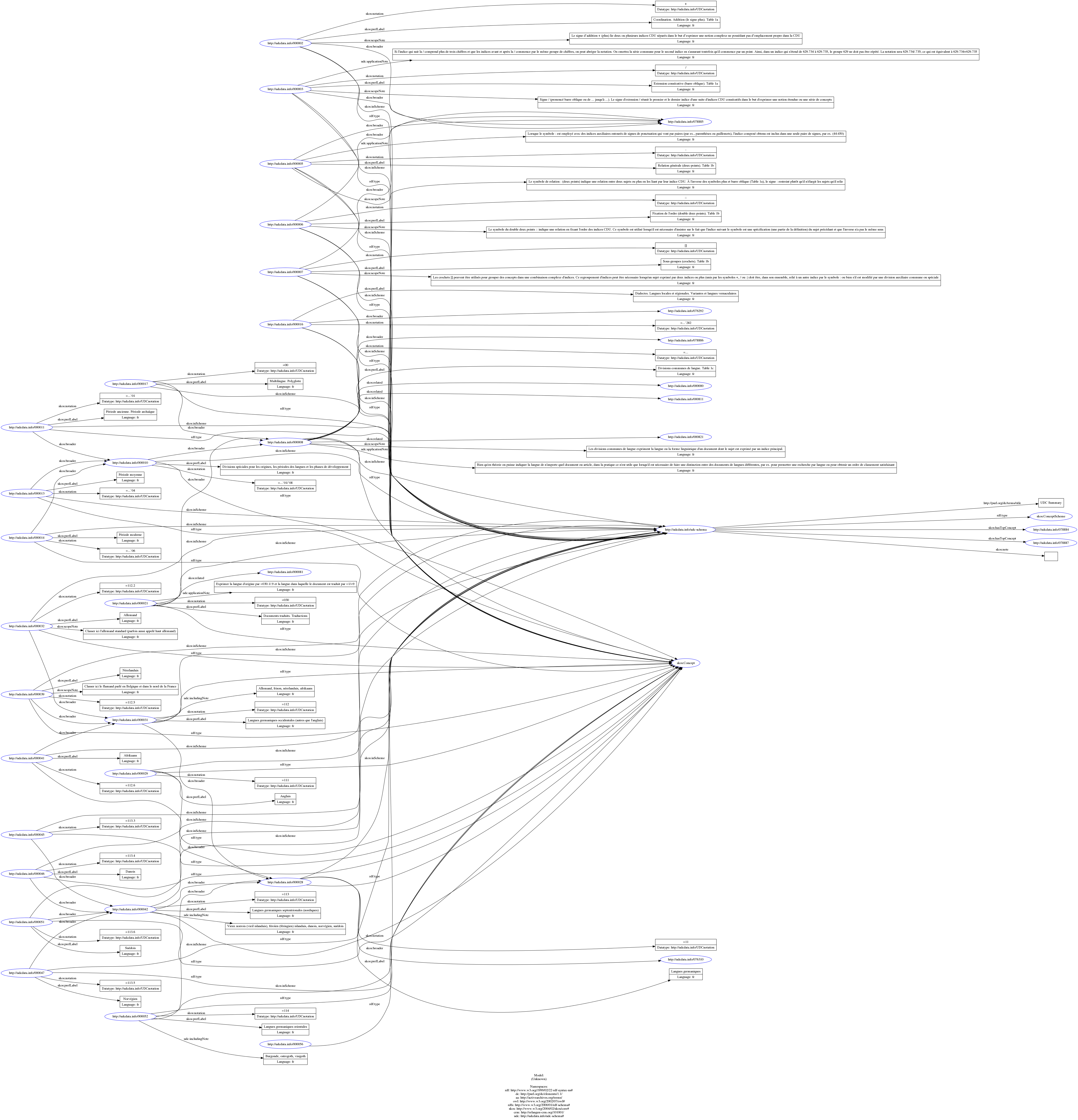
Mundaneum ID
| Mundaneum id | Caption | Person | Subject | Creator | Rights | |
|---|---|---|---|---|---|---|
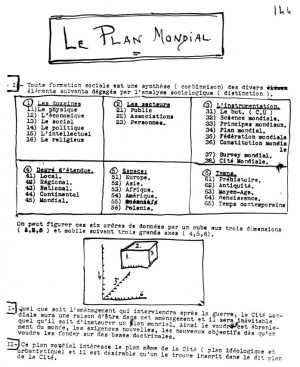 | EUM 14-120 | Dynamic visualization of the Plan Mondial | Paul Otlet | |||
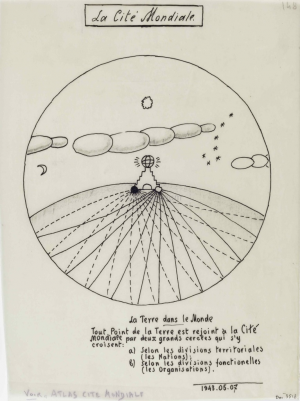 | ARC-MUND-EUMC-3518-001 | Schéma symbolisant la Cité Mondiale et le rattachement de tous les points de la Terre à la Cité. 07 mai 1943. | Paul Otlet | Public Domain | ||
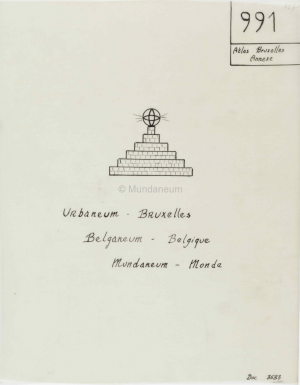 | ARC-MUND-EUMC-3583-001 | Atlas Bruxelles – Urbaneum - Belganeum - Mundaneum. Page de garde du chapitre 991 de l'Atlas de Bruxelles. | Paul Otlet | Public Domain | ||
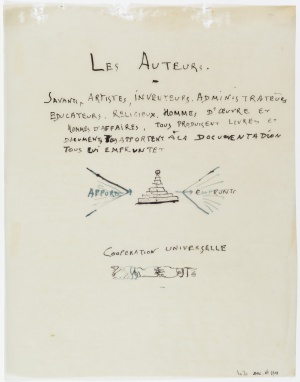 | ARC-MUND-EUMC-3708-001 | Paul Otlet | Public Domain | |||
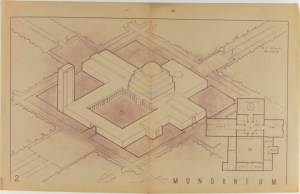 | ARC-MUND-EUMC-3518-001 | Paul Otlet | Public Domain | |||
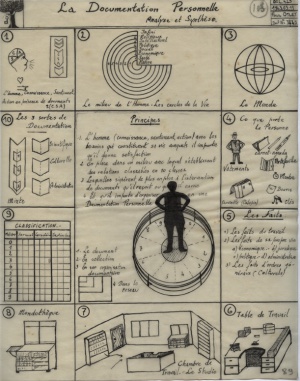 | ARC-MUNDA-EUMC-103-72 | Paul Otlet | Public Domain | |||
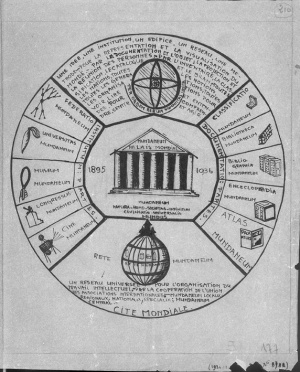 | ARC-MUNDA-EUMC-177 | Paul Otlet | Public Domain | |||
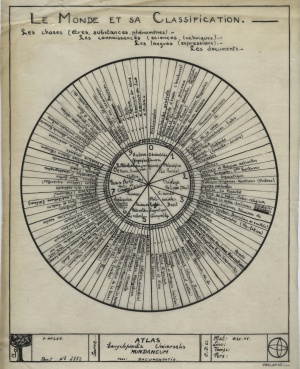 | ARC-MUNDA-EUMC-3852 | Paul Otlet | Public Domain | |||
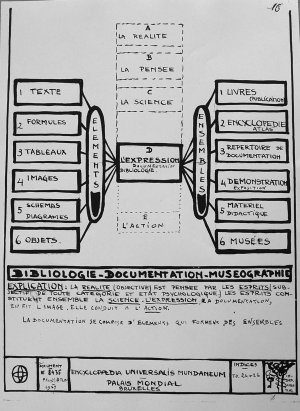 | EUM 8435 | Bibliology-Documentation-Museography: Expression as a double interface between processes of documentation and of thought | Paul Otlet | |||
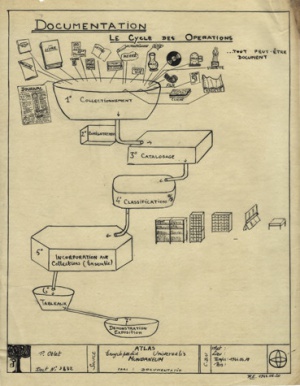 | ARC-MUNDA-EUM3?? | Paul Otlet | Public Domain | |||
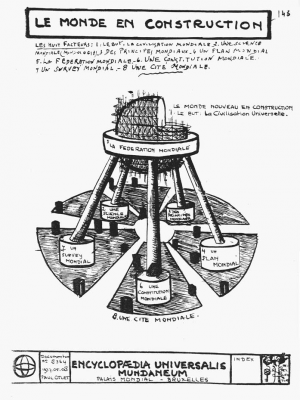 | EUM 9-81 | Otlet, ‘clavier’, manual and mechanical operation | Paul Otlet | |||
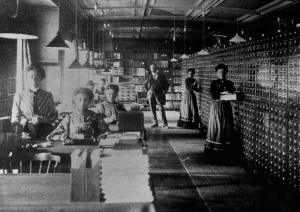 | ARC-MUNDA-PV-RBU1900 | Office International de Bibliographie, Salle de repertoires | ||||
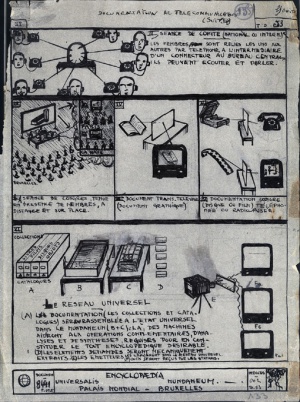 | ARC-MUNDA-EUMC-155-72 | Ce schéma de l'Encyclopedia Universalis Mundaneum illustre le côté précurseur de Paul Otlet en termes de télécommunication. Dès les années 1920, il imagine des systèmes de vidéoconférence et de consultation de livres à distance. | Paul Otlet | |||
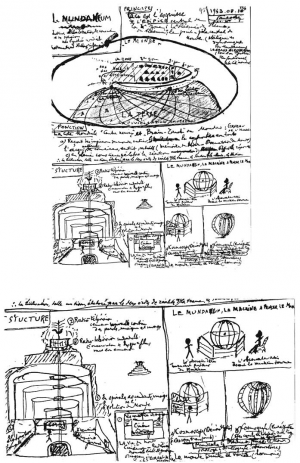 | EUM 14-120 | Mundaneum, transmitter of knowledge | Paul Otlet | |||
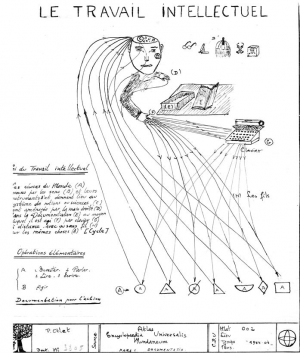 | EUM 8-74 | Otlet, ‘clavier’, manual and mechanical operations | Paul Otlet |
Drawers
Scanning fingerprints
Glued cards
Scenography
Mess
Otlet's teapot + falling papers
The WeTransfer files: filesharing
The Technical problem
Michael Moss
Licenses
UDC
